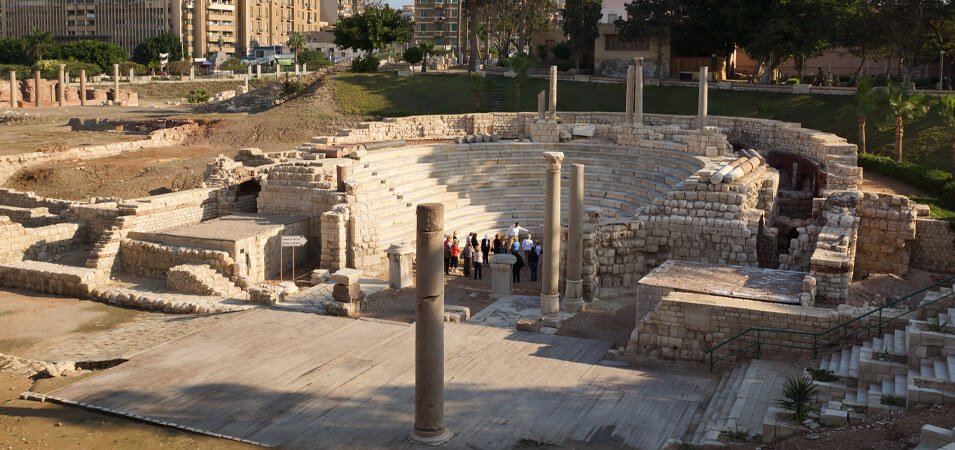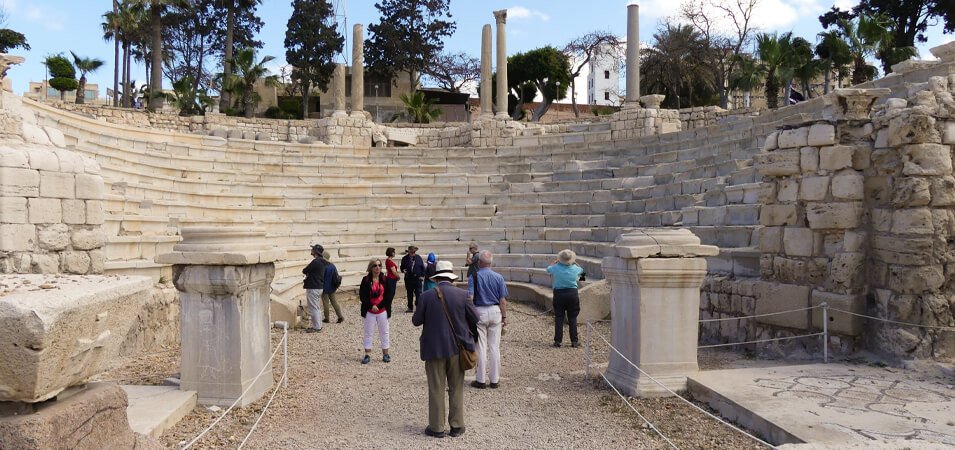The Roman Theatre in Alexandria is a stunning relic that embodies the grand historical tapestry of one of Egypt’s most celebrated cities. Founded by Alexander the Great in 331 BC, Alexandria quickly rose to prominence as a center of cultural, intellectual, and economic life. This coastal city on the Mediterranean was a magnet for philosophers, scientists, and artists, who gathered to exchange ideas, making it a melting pot of Hellenistic thought and innovation.
When Egypt became a Roman province in 30 BC, Alexandria was enriched by the empire’s culture, administration, and architectural brilliance. Among the lasting imprints of Roman influence is the Roman Theatre, a marvel of ancient design that showcases the sophistication of Roman engineering, the city’s cosmopolitan spirit, and the vibrant cultural life that once thrived here.
Historical Context of the Roman Theatre
Alexandria’s Hellenistic Glory Before Roman Rule:
Before Roman influence, Alexandria was already a beacon of scholarship and architectural wonder. It boasted the legendary Great Library, home to a vast collection of knowledge from across the known world, and the Lighthouse of Alexandria, one of the Seven Wonders of the Ancient World. The city’s strategic location at the crossroads of trade routes fostered a cosmopolitan environment that drew people from diverse cultures around the Mediterranean, making it a true hub of learning and exchange.

Roman Conquest and Cultural Fusion
The Roman era in Alexandria began with the defeat of Queen Cleopatra VII and Mark Antony in 30 BC. This marked a transformative period for the city, as it came under Roman rule and experienced a fusion of Roman administrative practices, architecture, and urban design. Roman architects and engineers brought with them their characteristic methods of construction and design, creating enduring structures like baths, amphitheaters, and, significantly, the Roman Theatre. This cultural blending resulted in a unique architectural heritage that reflected both Alexandria’s Hellenistic past and Roman grandeur.
Architectural Mastery of the Roman Theatre
The Roman Theatre in Alexandria exemplifies the exceptional craftsmanship and design principles that characterized Roman theatres across the empire. Unlike Greek theatres, which were often constructed on natural slopes, Roman theatres were freestanding structures that could be built anywhere, allowing for greater architectural flexibility. The theatre’s semi-circular seating area, known as the cavea, was designed with a tiered structure that accommodated social hierarchies, placing privileged seats closer to the stage. Constructed with durable stone and concrete, the seating was built to withstand the elements and time, a testament to the Romans’ dedication to quality.
The orchestra, a semi-circular performance space in front of the stage, served as the center for choral performances and later for principal actors. Roman theatres were known for their impressive acoustics, achieved through careful architectural design that allowed audiences to clearly hear every word and sound from the stage. The scaenae frons (stage front) was often elaborately decorated with columns, statues, and intricate carvings, enhancing the visual experience and symbolizing the importance of theatrical performances in Roman culture. The pulpitum, or stage itself, was elevated for optimal visibility and equipped with mechanisms to support scenic changes and special effects, adding to the dramatic appeal of performances.
Unique Design Innovations in Alexandria’s Roman Theatre
The Roman Theatre in Alexandria was particularly innovative, incorporating a series of underground passages and chambers that allowed for efficient crowd movement and supported stage machinery. These features not only improved the functionality of the theatre but also demonstrated the Roman architects’ adaptability to Alexandria’s urban layout and climate. Using locally sourced materials, they integrated the theatre into the surrounding landscape, showcasing the Romans’ commitment to harmonizing their structures with the city’s environment.
Construction Techniques and Roman Craftsmanship
Built during the reign of Emperor Septimius Severus (193–211 AD), the Roman Theatre reflects the Roman Empire’s commitment to enhancing infrastructure in its provinces. Archaeological evidence reveals the advanced techniques used by Roman engineers, including sophisticated masonry, the use of concrete, and an understanding of structural integrity that ensured the theatre’s longevity. By blending local and Roman materials, the architects created a theatre that felt both majestic and in harmony with its Alexandrian setting.
The Role of the Roman Theatre in Society
The Roman Theatre served as a central venue for Alexandria’s cultural and social life, providing a stage for dramas, comedies, musical performances, and public gatherings. It was a space where people from all social classes could come together to enjoy entertainment, share ideas, and witness civic ceremonies. In this way, the theatre contributed to the city’s social cohesion, embodying the values and artistic expressions of the Roman world while resonating with Alexandria’s own cultural identity.
The diversity of performances held at the Roman Theatre highlights Alexandria’s multicultural character. Performances included not only traditional Roman plays but also local and Greek-inspired works, offering a rich blend of theatrical experiences that catered to a wide range of tastes. The theatre thus became a symbol of Alexandria’s role as a cultural bridge between Rome and the East.
The Roman Theatre’s Lasting Legacy
Preservation of the Roman Theatre has been a continuous endeavor, with archaeologists and conservationists working to protect it from natural wear, urban development, and tourism impacts. Restoration efforts have aimed to maintain the theatre’s structural integrity while ensuring accessibility for modern visitors. This ancient theatre has not only endured through centuries but has also influenced later architectural developments, inspiring elements in theatre design across the Roman Empire and beyond.
Visiting the Roman Theatre Today

The Roman Theatre is located in the heart of Alexandria, making it convenient for visitors who are also interested in exploring other nearby historical sites. The theatre’s central location is complemented by the availability of modern amenities, ensuring that visitors can comfortably enjoy the experience. Key highlights include the intricately carved scaenae frons, the seating arrangements that offer insight into Roman social structure, and the underground corridors that reflect the ingenuity of Roman architecture.
For a memorable visit, it’s recommended to:
- Plan Ahead: Check the opening hours and any available guided tours, as these can provide valuable insights into the theatre’s history.
- Dress Comfortably: The site involves a fair amount of walking, so wear comfortable shoes.
- Bring a Camera: The theatre’s architectural beauty and historical ambiance make it a fantastic subject for photography.
- Take a Guided Tour: Tours offer expert explanations of the theatre’s design, its role in society, and its historical context.
FAQs
What is the history of the Roman Theatre in Alexandria?
The theatre was built during the reign of Emperor Septimius Severus in the early 3rd century AD, showcasing Roman architectural influence and serving as a venue for public events.
What types of performances were held here?
A wide range of events, including dramas, comedies, musical performances, and civic ceremonies, took place at the Roman Theatre, reflecting Alexandria’s vibrant social life.
How is the Roman Theatre preserved today?
Preservation includes archaeological efforts, restoration, and conservation to protect it from environmental damage while ensuring its accessibility.
What can visitors expect to see?
Visitors can explore the seating area, stage, and intricately carved facades, gaining insights into Roman architectural practices and Alexandria’s historical significance.
Conclusion
The Roman Theatre in Alexandria is a monumental reminder of the city’s illustrious past, standing as a testament to the blend of Roman and Hellenistic influences that defined Alexandria. Through ongoing preservation, it continues to provide a glimpse into the grandeur of Roman architecture and the vibrant cultural life of ancient Alexandria. Whether as a hub of social life in ancient times or as an educational site today, the Roman Theatre offers an invaluable connection to one of the Mediterranean’s greatest civilizations.
